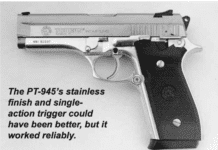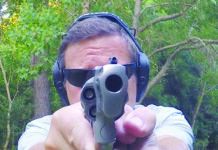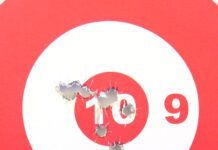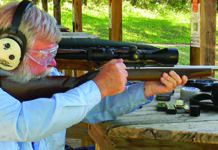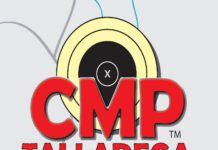This year hunters have a choice of two new non-toxic waterfowl loads other than steel. They are bismuth and tungsten. Both solve some of the problems encountered with steel, but neither are as good as lead. They may not even be as good as steel. To determine just how good the new loads were, we tested them in the popular 12 gauge 3-inch magnum load.
The main problem with steel shot is that it’s not dense enough. At least, it’s not as dense as lead shot and thus its downrange velocity falls off faster than lead. This results in just a little more wind drift. With a 14.5 mile per hour cross-wind, steel shot will drift 25.8 inches; lead will drift only 22.5 inches. The loss of downrange velocity is easy to compensate for, just switch to shot two sizes larger. There’s no lack of pellets because the less dense steel has more pellets per given weight than any of the other three alloys used for shot. In general, the use of steel shot two sizes larger will produce about the same pattern density, weight per pellet, and muzzle velocity as the other alloys do.
This trick of using shot two sizes larger isn’t mentioned in advertisements explaining the advantages of bismuth and tungsten over steel. Instead, the fine print explains that the same size shot was used in each test. This sort of test shows steel at quite a spectacular disadvantage.
Steel is also harder than lead; hard enough to damage shotgun barrels that aren’t designed for it, and hard enough to require a good thick cup wad. A thin sleeve won’t do. This limits the amount of steel shot a given load can shoot. Federal loads 1 1/8 ounce in the 3-inch magnum case; Winchester loads 1 1/4 ounce, Remington loads 1 3/8 ounce. Lead is loaded up to 1 7/8 oz. in the 3-inch magnum case.
The third problem with steel is that it just doesn’t penetrate quite as well as the other three elements. A steel pellet that weights the same and has the same velocity will be a little larger in diameter and thus won’t penetrate quite as far. Increasing the velocity will compensate for the larger diameter and the two steel loads we evaluated proved to be the fastest in this test, above 1,550 feet per second.
Beside not lead-poisoning the ducks, steel has another advantage over lead; it’s so hard that it doesn’t deform as it passes down the barrel. Our tests with a water trap showed that the very best lead shot, which was antimony hardened, copper plated and grex buffered, was still distorted in the shotgun. These dented pellets don’t fly as true or as fast as a round pellet and thus contribute to pattern spreading and stringing.
This year, Federal Cartridge Company has introduced a tungsten-iron alloy load for use on ducks and geese. It’s composed of 40 percent tungsten and 60 percent iron, formed in a die and sintered (it’s heated to form a coherent mass without melting). At the present, it’s available in only No. 2 and BB sizes. The alloy is almost as dense as lead and a lot harder, thus it needs the thickest, toughest shot cup wad in the industry. These thick walls limit the load to only 1 1/8 ounces, the same as Federal’s steel load, but it’s safe in any barrel designed for steel shot. It’s also hard enough to prevent pellet distortion in the barrel.
A competing load has been introduced by the Bismuth Cartridge Company. This alloy is bismuth with 3 percent tin. Bismuth is a metal similar to lead and almost as heavy, but not so cohesive. The 3 percent tin is an attempt to improve the cohesive properties, but, in our opinion, it’s not good enough. There is no need for a heavy, thick shot cup; a thin plastic sleeve does the job very well with these softer pellets. This leaves room for 1 5/8 ounce of shot. It’s safe in any modern shotgun barrel. If you have a fine old shotgun that had to be retired with the advent of steel shot, here’s your chance to take it out of the gun rack again. Bismuth acts quite like lead in flight. Since the bismuth loads shoot nearly half again as much shot as the other two, they are probably the most effective for killing waterfowl.
To see how well bismuth and tungsten loads performed, we tested them against steel and lead loads. The shotshells used in this evaluation were Bismuth No-Tox loads with BB and No. 2 shot, Federal Premium Tungsten loads with BB and No. 2 shot, Federal Premium Steel loads with BB and T shot and Winchester’s XX Lead load with BB shot.
The tests we used to evaluate these loads are explained toward the end of the article. Detailed results of our findings are included in the accompanying summary table. Here’s what we found:
The Results
Bismuth No-Tox
The problem with Bismuth lies at the end of the flight: the pellets disintegrate. We expect the poorer rifle bullets to separate or disintegrate on impact, but we didn’t expect shotgun pellets to do the same thing. Only a few of the bismuth No. 2 and BB pellets survived the trip into our water trap.
Most pellets disintegrated into a crunchy, gritty paste that we scooped off the bottom of the trap. They didn’t do any better when we shot them into a chicken (the kind you get from a supermarket, not a live one). We object to having our goose seasoned with disintegrated bismuth pellets! On the other hand, biting into a flake of bismuth will be less painful than biting down on a steel or tungsten pellet. While we expect the cook to remove the pellets, removing bismuth flakes from the meat is impractical. There are too many, they are too small, and the sharp edges make them adhere to the meat. Our Rating: Unsatisfactory if you intend to eat the meat.
Federal Premium Tungsten
We found the tungsten-iron alloy to be even better than lead, after it leaves the barrel. Not one pellet deformed in our bullet trap. This leads to a compact load in flight without spreading or stringing out. The BB load had a 94 percent pattern and it had the best penetration of the test. Unfortunately, it’s only available in 1 1/8 ounce loads. Our Rating: Best of test.
Federal Premium Steel
In our opinion, the steel loads were almost as good as the tungsten, if you choose shot two sizes larger. It patterned well, 86-88 percent, and didn’t deform at all. Penetration seemed about as good as lead, probably a result of its better velocity. Our 1 1/8 ounce steel loads had the highest velocities of the test, but that’s a rather light load. You can buy heavier, slower steel loads, up to 1 3/8 ounce, if you want them. Our Rating: Very Good.
Bottom Line
Stay with steel, it’s almost as good as tungsten. While tungsten cost three times as much as steel, it’s not three times better.
How We Tested
Our first test was a shot fired into our water trap, a 54-inch horizontal water column, to see if pellets deformed. The front end was closed with a neoprene diaphragm. We used a Winchester Ranger Model 1200 shotgun with screw-in chokes. The shots were fired through a 3-foot muffler to control noise and limit gas interference, through an Oehler Model 35 chronograph, and into the water. We measured the muzzle velocity and recovered the shot for inspection and photography.
The first shot was the Winchester lead BBs. We were surprised to find all of them dented and distorted. Suspecting they had hit the water column going too fast, we slowed the next load down with 4 inches of sawdust. It didn’t help, all of the BBs were still distorted. We tried a foot of sawdust next with the same results even though some of the BBs didn’t even get through the sawdust. We’re satisfied that all of the distortion occurred in the shotgun.
While the lead pellets distorted, the bismuth pellets disintegrated in the water trap test. Suspecting our higher than normal impact velocity and denser than duck impact medium was the cause, we tried shooting into a chicken at 25 yards. We got exactly the same results; the chicken was littered with bismuth flakes and they were practically impossible to remove.
Our second test was measuring the down-range velocity. We used the same chronograph with a shield made of 2-inch by 6-inch boards to protect the sky screens. Most of the loads registered on the chronograph, but we didn’t have quite enough light for two of them. The velocities for these two were calculated.
Our third test was patterning each load at 40 yards. The 30-inch circle, shown in the photographs, was drawn to include the most possible pellet holes. Suspecting we may have been over-choking some of the bigger and harder loads, we tried a modified choke on the last shot, Federal’s size T steel shot. We got a more uniform pattern and four more pellets in the circle. But, this doesn’t show what the load will do in your shotgun; you’ll have to pattern it yourself to determine that.




